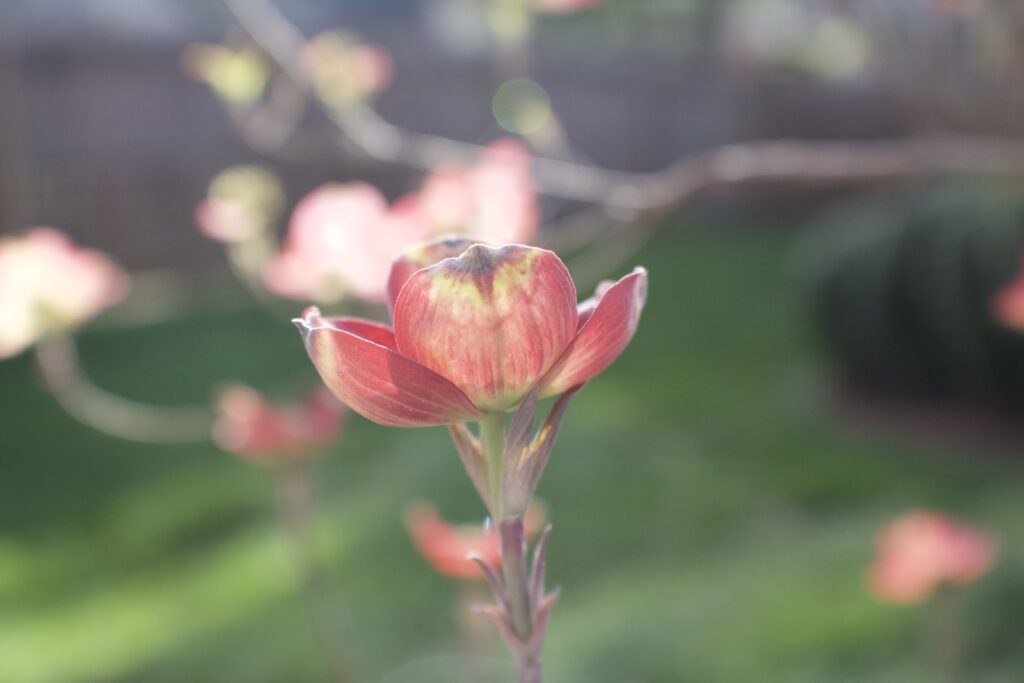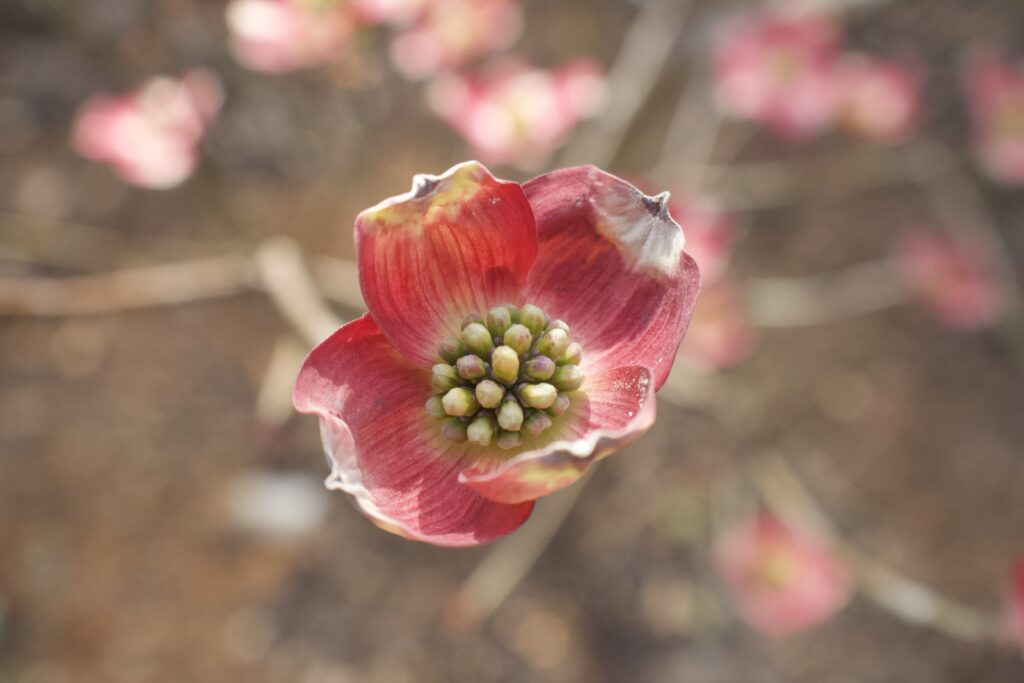
For Trinity Hamm, a love for agriculture started on her family’s small hobby farm in southern Pennsylvania. In high school, Hamm joined FFA, a student organization for those interested in agriculture and leadership, and started learning more about plants through floriculture competitions. That love of flowers led Hamm to earn her bachelor’s degree in plant sciences at Penn State.
Hamm then came to Knoxville to earn a master’s degree in entomology and plant pathology. Now, as a PhD student in Dr. Meg Staton’s lab, she’s combining her passion for plants with her new love for coding, studying the genetics behind what makes flowering dogwoods pink or red.
Q&A with Trinity Hamm
Can you tell us a little bit about yourself?
I come from a small town in Southeastern Pennsylvania, where my love for agriculture took root on our family’s hobby farm. As an officer in my high school’s FFA chapter, I immersed myself in floriculture competitions, and it was there that I realized my passion for plants. Little did I know that my fascination with flowering plants would one day lead me to a PhD program!
I earned my bachelor’s degree in plant sciences with a minor in plant pathology from Penn State, eager to keep exploring the world of plants. That journey took me to Knoxville, where I pursued my master’s degree in the Department of Entomology and Plant Pathology under Dr. Robert Trigiano. Now, for my PhD, I’ve joined Dr. Meg Staton’s lab to dive into the genetic regulation of bract and leaf color in flowering dogwood while expanding my bioinformatics expertise.
What is your current concentration?
I am in the bioinformatics, genomics, and molecular interactions concentration. I chose this field because I love breaking down biological problems and building solutions back up to better understand them with computer code.
What is your current research question?
My current research question is understanding which genes in a region of the flowering dogwood genome, that is associated with leaf and bract color, are actually controlling the pink/red pigmentation in the leaves and bracts.
Can you tell us more about your research and its potential impact?
There is only one public dogwood breeding program in the country right now, which is up at Rutgers University. Currently, decisions in the breeding program are made just based on what the trees look like. They are mainly looking at disease resistance to powdery mildew and the color of the bracts. Bracts are modified leaves that subtend the true flowers and are the showy part of the flowering dogwoods in the spring. Making decisions based on what the trees look like involves using a lot of space to grow a lot of trees for 3-5 years until they flower and can assess disease resistance.


Consumers want red/pink bracted dogwoods that are powdery mildew resistance, and my research fits into understanding the bract color part of the equation. If we understand what is regulating the pigmentation, we can develop genetic markers to be able to screen plants when they are a couple of weeks old. This would help dogwood breeders to use up less space in the field on trees they know they have no interest in.
What challenges have you faced in answering your research question?
It has been difficult to build up genomic resources for flowering dogwood to give context to the research question of what is regulating the bract and leaf color. It has also been difficult to narrow down what exactly is important for regulating these traits. We have a low number of trees in our population that varies for bract and leaf color, so it has been difficult to statistically associate a small region of the genome with the traits. We currently have ~14 million basepairs that we know are involved, but there are a lot of genes in there that could be important.
What academic course has been your favorite and why?
My favorite course was EPP 644, Bioinformatics Applications. I had told myself (and others) that I was not smart enough to write or understand code. This class was the first time that I felt like I could not only code, but I thoroughly enjoyed doing it.
How has your academic training in the department prepared you for your future career?
I think a large part of my journey has been doing things I didn’t think I could do. The EPP department has been a conducive environment for me to grow and gain confidence in my abilities. I had no interest in plant breeding before I started my PhD, but now I know I want to provide genomics and bioinformatic support to breeding programs in the future. My PhD has given me the skill set to do exactly that and the confidence to figure out any hurdles that I will inevitably encounter in my scientific career.
What do you believe is your biggest academic achievement?
I think my biggest academic achievement has been getting a Co-Op with Bayer Crop Sciences. I did a 6-month Co-Op last summer/fall to build and understand vegetable pangenomes for Bayer. I learned so much and had the opportunity to work with some amazing people, all while learning about industry. It was a wonderful experience, and I would highly recommend students try to get an internship or co-op in industry.
What has been the highlight of your graduate school experiences so far?
There are so many experiences that have been wonderful in grad school, so it’s hard to choose one. I’ll give you my top three:
- My fellow grad students in this department. There’s a group of us that try to get together every week and try out different breweries around Knoxville. Even though I don’t have anything to do with bugs, my fellow Beer and Bug Buddies have been my rock through this.
- Getting to take pictures of flowering dogwoods in bloom with the camera my parents got me for high school graduation. There was a (short) period of time that I wanted to be a photographer, so getting to repurpose this camera into a new passion of mine was very satisfying.
- Sampling ash trees in the Smokies. The group of people made it awesome, but more than that, being involved in an effort to save ash trees is inspirational. The picture is me holding an ash tree branch that fell into the river (I didn’t have to jump in the river to get it, but I was ready to).
What are your favorite things to do on campus?
This probably isn’t a surprise to anyone, but I love to look at the plants. I love the trees around the commuter lot in the fall. I love the cherry trees along the river and the tulips at the entrance in the spring. I love walking around the UT gardens any time of year. Sorry, UT, I’ll always think Penn State has the prettier campus, but we have a pretty great campus here, too.
Are you involved in any extracurricular activities?
I was the Outreach Chair for our GSS for two years. This gave me the opportunity to talk with the public at events like Ag Day and the Butterfly Festival, as well as coordinate visits to local high schools to chat with students about the research that goes on in our department.
What are your favorite hobbies?
My favorite hobbies are hanging out with friends, going for walks, and building Lego sets with my boyfriend. I recently bought some watercolors because I also want to learn how to paint plants! I also really love looking at Christmas lights.
What advice would give to a prospective student considering this program?
I would advise prospective students to find an advisor and a research project that they are passionate about and can incorporate things they love into the research. Grad school is not easy (and it’s not meant to be), but if you have passion for your project it makes it much easier to push through the inevitable hurdles and setbacks you will face in research.
Also, if you find an advisor that finds the balance between encouraging you to make mistakes/learn for yourself and supports you when you are lost, that helps a lot, too! I think both my PhD advisor (Dr. Meg Staton) and master’s advisor (Dr. Bob Trigiano) helped me set up a balance that worked for me. So, I may be biased, but I think this department is a great place for this.
Is there anything you would like to share?
The flowering dogwoods are blooming and don’t forget to get them out—whether it’s on campus or on one of the Dogwood Arts Festival Trails!
